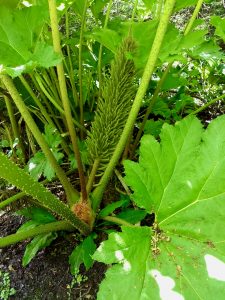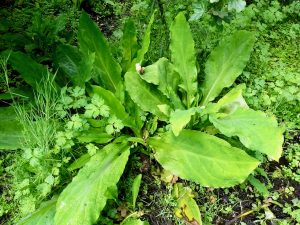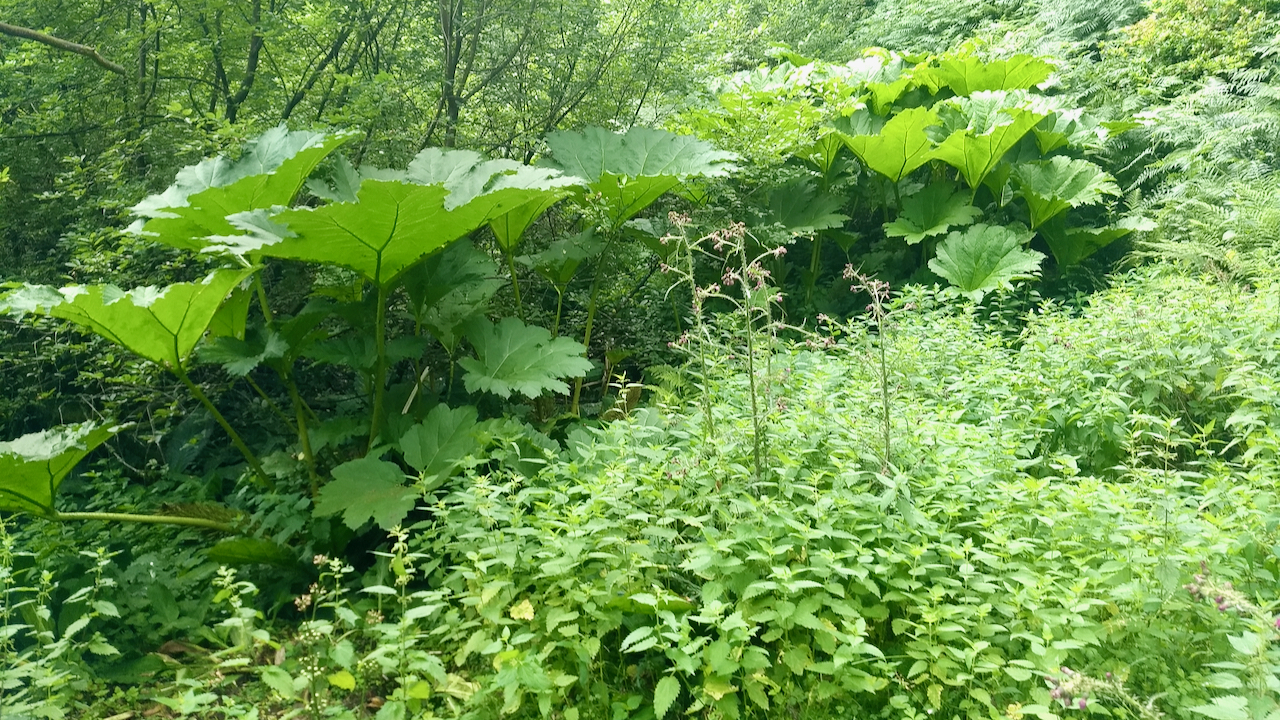A giant rhubarb looking plant, like something out of Jurassic Park.

I think it is Gunnera tinctoria or Chilean rhubarb, an ornamental plant native to Chile and Argentina.
It a massive plant with leaves that can reach up to 2½ metres across. The underside of the leaves and their stems have small thorns, not too annoying, more like a rasp.
I am told that this plant can still be brought in garden centres although fully grown it will dominate all but the largest garden.
In New Zealand, it is considered a serious invasive species but the target today was another pest plant, the American Skunk Cabbage (Lysichiton americanus) which was also introduced into this country as an ornamental plant for bog gardens. As the name suggests it is native to North America.

This plant is a lot more prolific, its seeds have the ability to disperse far and wide down the watercourse. Its rhizomes grow deep in the bog and needs complete removal.
I am in an overgrown garden in Bransdale volunteering for the National Trust. We’ve attacked the plant before, two years ago, but complete clearance is practically impossible. Some plants are hidden away in the deepest scrub, and bits of the rhizome inevitably remain.
The garden was built by Lord Feversham in the 1950s to provide work for his employees when not needed to attend his shooting parties. Ernest Cowton (1903 – 1979), Lord Feversham’s gamekeeper, tells the story in his booklet “My Moorland Memories”:
“As there was not enough work around the Lodge to keep a man employed full time, Lord Feversham started work making what could be described as a wild garden in a small valley at the foot of the hill leading up to the Church and Lodge. Before any planting of shrubs or bulbs could be done, quite a bit of work draining the wet places had to be carried out. As this man was a good and conscientious worker, things soon began to take shape and during the five years before he left to emigrate to Australia stoned paths had been made and the sides of the drains planted with different colours of primulas. Flowering cherries had been planted and beds of azaleas and rhododendrons put, in, besides other bulbs and plants too numerous to mention. Another caretaker was employed and he stayed for two years but, for work, he was not in the same category as the first one. The gardens I have mentioned deteriorated considerably with the growth of rubbish. In fairness to the second gardener, however, it was a very wet summer and owing to the wet conditions he could not work and this contributed to the deterioration. After the second caretaker left, a new man was not engaged to take his place and my wife took over the work of keeping the Lodge clean and tidy, members of the Estate forestry staff coming up from Helmsley occasionally during the summer to keep the rubbish cut1“My Moorland Memories” A booklet by (William) Ernest Cowton (1903 – 1979). http://Helmsleyarchive.org.uk. (2014). [online] Available at: http:// www.helmsleyarchive.org.uk/info/HA08778.pdf [Accessed 29 Jul. 2021]..
- 1“My Moorland Memories” A booklet by (William) Ernest Cowton (1903 – 1979). http://Helmsleyarchive.org.uk. (2014). [online] Available at: http:// www.helmsleyarchive.org.uk/info/HA08778.pdf [Accessed 29 Jul. 2021].

Leave a Reply